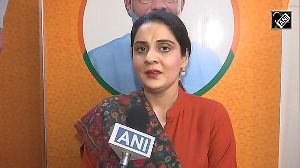Everyone working in the organised sector -- i.e. those who are members of the Employees' Provident Fund -- will now have social security numbers.
Three years ago, the Employees' Provident Fund Organisation launched Project Re-Inventing EPF India with the prime objectives of providing the PF subscribers better and efficient service, helping employers reduce the cost of compliance and providing the organisation the ability to register geometric growth.
From this emerged the idea of the allotment of the 14-digit unique identification number -- National Social Security Number.
In March 2003, the then labour minister Saheb Singh Verma, in the presence of President A P J Abdul Kalam, issued the first National Social Security Number.
The organisation then decided to take it across the country. This is a gigantic task, taking into account the estimated 3.5 crore (35 million) members of the Employee's Provident Fund. The procedure was then carried out in small phases for effective data collection.
It has now reached Mumbai and members of the provident fund have been told to apply for this number. This will require every employee to compulsorily fill a form for obtaining the NSSN.
The criteria considered for the allotment of the NSSN include the centralised control of uniqueness, ensuring the least manual intervention during allotment and near 100 per cent uniqueness accuracy levels.
The organisation hopes it will go a long way towards solving the problem of providing social protection to migrant labour and to make the database of EPFO adaptable to the present trend of high job mobility among workers.
EPFO has started issuing the NSSNs for 'unique identification' of the beneficiaries of social security schemes, not only under the Employees Provident Fund (Miscellaneous Provisions) Act, 1952, but also under the 'Unorganised Sector Workers' Social Security Scheme.'
The government also plans to provide social security numbers to those working in the unorganised sector.
How does this SSN help you?
- This will be of great help to individuals when switching jobs or leaving the city or state.
- The PF subscriber will be able to avail of a unique identification for their provident fund account across India.
- The subscriber will be able to get information of his PF account from any of the 260 PF offices in the country.
- Just as in a bank account, online enquires will be possible and up-to-date information on credit balance of the members account will be available. He can get a printout of his account balance for the last completed month.
- Automatic transfer of account on change of job or location will be possible.
- The identity number, which is independent of his/her employers, will remain constant and hence change of job location will not involve any transfer of account.
- The subscriber will be able to file his PF claim for withdrawal of advance at any of the 260 offices.
- The employers can file the monthly returns electronically.
- Also, the number of returns to be filled in a year will be reduced to 12 forms from the present 48.
-
Each employer will be given a unique business number which will be integrated with the Permanent Account Number (PAN) issued by the Income-Tax department.
The deadline set by the provident fund authorities for the issuance of NSSNs is March 2005.
However, there is a bleak chance that this will be met. For instance, in Nagpur, work on it has been stopped by the vendors who say that payments from the PF office have been delayed. Apparently, this is the same reason that work in Solapur too has been stopped.
Siemens, C S Software Enterprise Ltd and the Unit Trust of India are the vendors selected by the Employees' Provident Fund Organisation. While C S Software has the task of collating the data and digital photographs and sending all of it to UTI for the cards to be made, Siemens is responsible for the hardware.
The government is hoping that kiosks will be set up where these magnetic strip cards can be used to access information.
To cost Rs 700 crore!
Taking all costs into account, it is estimated that each card costs the government Rs 200. Multiply that by the number of members of the provident fund and you have a project cost of more than Rs 700 crore (Rs 7 billion).
While it will not function as a one-stop information code as it does in, say, the United States -- where one cannot buy insurance, open a bank account, take up a job or purchase a home without a social security number -- it will be to provident funds what PAN (Permanent Account Number) is to income tax.





 © 2025
© 2025